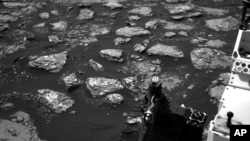The United States space agency, NASA, says its Mars exploration vehicle recently recorded a high level of methane gas on the planet. The discovery is exciting because the presence of methane gas could support the case for life on Mars.
NASA’s Curiosity vehicle recently recorded the largest level of methane ever measured during its seven-year Mars mission.
Methane has no color or smell. A special instrument on Curiosity’s Mars Science Laboratory recorded the increased gas level. The device, called a laser spectrometer, measures levels of chemical elements and gases in the Martian atmosphere. In addition to methane, the instrument can record levels of water and carbon dioxide.
Nearly all the methane gas found in Earth’s atmosphere is produced by biological activity. It usually comes from animal and plant life. But it can also be formed by geological processes, such as interactions between rocks and water.
NASA said the increased methane was measured to be about 21 parts per billion by volume (ppbv). One ppbv means that if you take a volume of air on Mars, one billionth of the volume of air is methane.
It was not the first time Curiosity has found methane gas in the Martian atmosphere. About a year ago, NASA announced that Curiosity had discovered sharp seasonal increases in the gas.
This time, NASA said the measured methane gas level was clearly larger than any others observed in the past. NASA officials even temporarily stopped Curiosity’s other activities to investigate further.
“It's exciting because microbial life is an important source of methane on Earth,” NASA said in a statement announcing the discovery.
However, Curiosity’s team carried out a follow-up methane experiment that showed a sharp drop in levels of the gas. The second examination found the level was less than one part per billion by volume. That number was “close to the background levels Curiosity sees all the time,” NASA said.
The rise and fall of the methane gas levels left NASA scientists with more questions than answers. The scientists are continuing to study possible causes for the sudden increase.
"The methane mystery continues," said Ashwin Vasavada, Curiosity's project scientist at NASA's Jet Propulsion Laboratory in Pasadena, California. "We're more motivated than ever to keep measuring and put our brains together to figure out how methane behaves in the Martian atmosphere."
Curiosity does not have instruments that can exactly identify whether the source of the methane is biological or geological. One leading theory is that methane is being released from underground areas created by possible life forms that disappeared long ago.
Even though Mars has no active volcanoes, scientists believe it is also possible that methane is being produced by reactions involving carbon materials and water.
A clearer understanding of methane levels over time “could help scientists determine where they're located on Mars,” NASA said. Scientists hope this understanding will come as Curiosity continues to collect methane data in its search for possible life.
I’m Bryan Lynn.
Bryan Lynn wrote this story for VOA Learning English, based on reports from NASA and Agence-France Presse. Caty Weaver was the editor.
We want to hear from you. Write to us in the Comments section, and visit our Facebook page.
________________________________________________________________
Words in This Story
mission – n. an important task, usually involving travel somewhere
geological – adj. relating to the study of rocks, soil and the physical structure of the Earth
volume – n. the number of amount of something
microbial – adj. relating to microbes (very small living things)
motivate – v. to cause someone to behave in a particular way
determine – v. to control or influence directly
locate – v. find or discover the exact position of something











